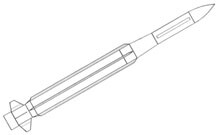 |
||
|
Director, Operational Test & Evaluation |
||
| FY97 Annual Report | ||
FY97 Annual Report
EVOLVED SEA SPARROW MISSILE (ESSM)
| Navy ACAT II Program 2,600 missiles (US only) Total program cost (TY$) $1,700M Average unit cost (TY$) $0.650M Full-rate production FY00 Prime Contractor Hughes Missile Systems Co. Tucson, AZ | |
SYSTEM DESCRIPTION & CONTRIBUTION TO JOINT VISION 2010
The Evolved Sea Sparrow Missile (ESSM) is a short range missile intended to provide self-protection for surface ships. On Aegis ships, ESSM will be launched from the MK 41 Vertical Launch System, requiring a thrust vector control system on the ESSM rocket. On non-Aegis ships (aircraft carriers, amphibious assault ships, other surface combatants), it will be fired from other launch systems. ESSM uses an 8 inch diameter forebody that includes a modified guidance section from the in-service RIM-7P Sea Sparrow. The guidance section, which includes a radome-protected antenna for semiactive homing, attaches to a new warhead section. The forebody is attached to a new 10 inch diameter rocket motor which provides higher thrust for longer duration than predecessor Sea Sparrow missiles. ESSM will use skid-to-turn steering (tail control) whereas earlier Sea Sparrows were wing-controlled. ESSM will retain capability of the RIM-7P missile but will also have capability against maneuvering anti-ship missiles. ESSM is being developed as a multinational cooperative effort with several allied nations.
ESSM contributes to the JV 2010 concept of full dimensional protection in that it enhances ship self protection against air threats that have "leaked" past outer air defenses. Given that some of the ships that will use ESSM are also platforms from which strike operations will be executed, ESSM indirectly contributes to the concept of precision engagement.
BACKGROUND INFORMATION
Milestone II was conducted in November 1994. The TEMP was approved by OSD in January 1995 through the first at-sea phase of developmental testing, results of which would have provided the data for an operational assessment, to support the LRIP decision. This provisional approval was because the aerial targets proposed in the TEMP for the DT and OT in support of the full production decision were not acceptable in adequately representing anti-ship cruise missile threats. (Since that time, the PEO(TAD) has taken initiatives to obtain targets that are more threat-representative.) Critical Design Reviews (CDR) were conducted for the missile sections, the all-up missile round, and the modified MK 41 vertical launch system during 1997. The original schedule included DT/OA in FY97 on a fleet ship, DT/OT on the Self Defense Test Ship (SDTS) in FY98, operational evaluation in FY99, followed by the BLRIP decision in July 1999. As of this writing, program is being restructured, with LRIP to be supported by an OA based on DT firings at the White Sands Missile Range (WSMR), NM.
TEST & EVALUATION ACTIVITY
Testing activity during FY1997 consisted of DT conducted at the White Sands Missile Range, NM (a restrained test vehicle firing in a MK 29 rail launcher during May and a blast test vehicle firing from an allied MK 48 vertical launcher during August) as well as tests at the section level (warhead and rocket motor). Several planning meetings were conducted to prepare for the DT/OA on a fleet ship (FY98) and the DT/OT phase on the SDTS (scheduled for late FY98). The fleet ship DT/OA has been cancelled.
TEST & EVALUATION ASSESSMENT
The initial overall OT&E program is considered inadequate in that planned testing does not support resolution of a critical operational issue (COI) of anti-air warfare system effectiveness identified in the TEMP, as it applies to Aegis ships. This COI is stated as "Will the ESSM and its supporting fire control and launching systems yield acceptable probabilities of kill or provide adequate ship's self-defense against specified threats in clear and ECM environments?". Except for very limited land-based DT with the simulated Aegis system at WSMR, the initial test program prior to the full production decision includes at-sea missile firings only from the rail launchers used with the NATO Sea Sparrow System. (Although there will be firings of ESSMs from vertical launchers, these are from ships of allied nations that use fire control systems other than Aegis.) There is no scheduled at-sea testing of ESSM from an Aegis ship prior to the full production decision. This is being addressed by PEO TAD) in restructuring of the T&E program.
|
NEWSLETTER
|
| Join the GlobalSecurity.org mailing list |
|
|
|


